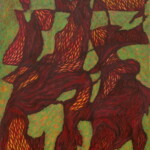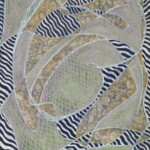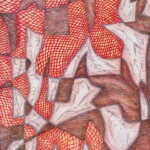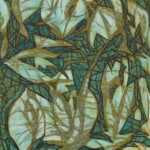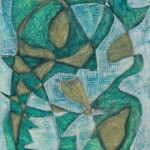The music in this album was improvised soon after I first picked up the accordion, and my limited control of the instrument shows. It isn’t played well, and I don’t think it is as musically interesting as Mirror Echo. But I include it here because it is a completed project, and as the antecedent of Mirror Echo, a comparison might be interesting. You might like one or two pieces in it.
Altered Perceptions, an art show hosted by RVA’s Artspace Gallery in April 2012 inspired Accordionated Perceptions, an album of accordion music. The exhibition included paintings by my sister Dana Frostick, displayed here:
Dana’s statement describing her process in creating this series of paintings reminded me of the musical improvisation or composition process. The images or sounds seem to pre-exist in another dimension, and the artist’s or composer’s task is to assist them in coming into this dimension. Of course, the artist or composer adds something personal to the result, but the aim is to let the work of art express its own life and logic.
Many artists describe their creative process in a similar way, but her particular words led me to attempt this project: to improvise music while physically at the exhibition. I didn’t know how it would turn out, but I thought I should try, and am pleased with the results.
Four times while the show ran, Dana turned the paintings ninety degrees, so they could be seen from four perspectives. The recording was made at one of these turnings, on a Saturday afternoon just before the gallery opened. At the beginning of track 11, you can hear in the background a few guests arrive and talk with Dana.
The accordion is an altered IORIO Symphonic Grand with H+M+L treble reeds and five sets of bass reeds. (More about the alterations later.)
Summation: “For a Moment There’s a Vision”
“For a moment, there’s a vision of earth and heaven in balance.” The last piece expresses the departing feelings evoked by the whole show, with an unfinished song in a style inspired by the paintings.
The Accordion
Originally, it contained an electronic interface and an extra register stop on both sides, to turn off the accoustic sounds from that side. By modifying the now useless 4th bass stop, and also the 3rd, I was able to modify the bass machine to produce four new reed combinations in addition to the original three. The reed combination selected by the 3rd or 4th stop now depends on which other stop was pressed immediately before it, so sometimes it is necessary to press two stops in sequence to get the desired bass sound.
Making the Recording
The final recording is 47 minutes extracted from the raw 62-minute recording. The original was altered by:
1) cleaning up the track transitions while keeping the flavor of the live gallery experience,
2) clipping out nine segments of unredeemable or boring playing from the middle of some tracks, and
3) reducing disconcerting volume changes caused by not having the accordion completely under control near the beginning and end of the hour.


